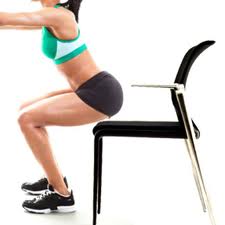The squat is a great exercise for your legs. It is a popular exercise that has been around for a long time. Unfortunately, it is often performed incorrectly. When done with an incorrect technique, not only are you not getting the maximum benefit from your hard work, but you may also be setting yourself up for a potential injury down the road.
The squat is aimed at strengthening the quadriceps muscles. The quadriceps is made up of four large muscles that lie along the front of your thigh. These muscles act to extend, or straighten, the knee. These muscles are used in everything from jumping and running, to getting up from a chair. The squat also works your gluteals (buttocks).
The proper technique for a “functional squat”, (vs. a power lifting squat), is as follows. Stand with your feet about shoulder width apart. Keep your back in a “neutral spine” position. Slowly lower your buttocks towards the floor (as if you were going to sit in a chair). Your knees should remain over your feet. The most common mistake is allowing your knees to come too far forward. Your buttocks should not go straight down towards your feet, but rather, extended behind you. Keep in mind that you should always be able to see your toes. By letting your knees go too far forward, you increase the load on the back of the patella (kneecap). This may lead to pain and dysfunction. Another thing to remember is to keep your knees and feet slightly rotated outward and to keep knees equal distance from each other throughout entire squatting motion (i.e. don’t let your knees come together or bow out as you bend down) (see picture below). The depth of the squat may vary. As a general rule, your knees should not exceed 90 degrees of flexion. Which means you should stop when your thigh becomes parallel to the floor. By going too deep with your squat, you are increasing the load on the meniscus. The meniscus is the “cushion” in your knee that protects the surfaces of the bones. One of the most important things to remember is, this exercise should not cause pain. We have all heard the old saying: “No pain, no gain”. Having this type of attitude when you exercise will most likely result in an injury rather than strong, healthy muscles and joints. Pain is your body’s way of telling you that something is wrong, and it should not be ignored. I think the saying should instead say, “No work, no gain”. If you are having any pain with this exercise you should try to squat less deep or try not doing as many repetitions. If you continue to have pain with squatting, or for that matter, pain with stairs, running, jumping or after sitting for a while, give us a call. You may have an injury that could be helped by physical therapy. If not, have fun and keep on squatting!

For a demonstration and instruction on how to do these squats properly, consider joining COAST Physical Therapy Services Santa Cruz fitness training program. You’ll be supervised by our qualified and helpful staff of trainers and experts.